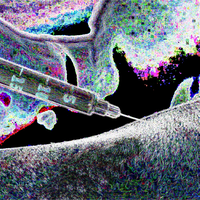| Lys | |
|---|---|
| Salts [] | |
|---|---|
| Lysine acetate | |
| Lysine monohydrate | |
| Lysine phosphate | |
| Lysine malate | |
| Lysine aspartate | |
| Lysine carbonate | |
| Lysine succinate | |
| Lysine hydrochloride | |
| Esters [] | |
|---|---|
| Lysine acetate | |
| Lysine stearate | |
| Molecular structure via molpic | |
| Conformer structure via 3Dmol.js | |
| Molecular formula | C6H14N2O2[1] |
|---|---|
| Molecular mass | 146.19 g/mol[1] |
| Predicted LogP | -3[1] |
| Chirality | racemic[2] |
| Identifiers [] | |
|---|---|
| IUPAC name | 2,6-diaminohexanoic acid[1] |
| SMILES | C(CCN)CC(C(=O)O)N[1] |
| InChI | InChI=1S/C6H14N2O2/c7-4-2-1-3-5(8)6(9)10/h5H,1-4,7-8H2,(H,9,10)[1] |
| InChIKey | KDXKERNSBIXSRK-UHFFFAOYSA-N[1] |
| Dosing |
|---|
Lysine
(Redirected from L-Lysine)
Lysine (also known as DL-Lysine, (RS)-Lysine, CCRIS 8600, (+-)-2,6-Diaminohexanoic acid, DL-α,epsilon-Diaminocaproic acid, Ec 200-740-6, (+-)-Lysine, 200-740-6, (+/-)-2,6-Diaminocaproic acid or H-DL-Lys-OH) is a substance of the amino acid class.
Chemistry
Lysine is typically found in the form of its acetate, monohydrate, phosphate, malate, aspartate, carbonate, succinate and hydrochloride salts or its acetate and stearate esters.
Stereochemistry
DL-Lysine is a racemic mixture of the logical stereoisomers:
| Stereoisomers [] |
|---|
See also
External links
- Lysine (Wikipedia)
- Lysine / D-Lysine / L-Lysine (Wikidata)
- Lysine / D-Lysine / L-Lysine (PubChem)
- Lysine / D-Lysine / L-Lysine (ChEMBL)
- Lysine / D-Lysine / L-Lysine (ChEBI)
- Lysine / D-Lysine / L-Lysine (Common Chemistry)
- Lysine / D-Lysine / L-Lysine (KEGG)
- Lysine / D-Lysine / L-Lysine (UNII)
- Lysine / D-Lysine / L-Lysine (EPA DSSTox)
 Anodyne
Anodyne